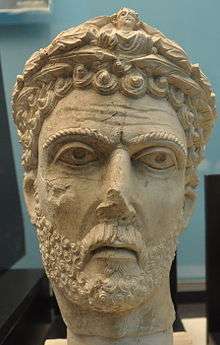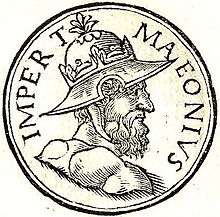List of Palmyrene monarchs
House of Odaenathus
| Portrait | Name | Ruler From | Ruler Until | Relationship with Predecessor(s) | Title | Notes |
|---|---|---|---|---|---|---|
 |
Odaenathus | 260 | 267 | King of Palmyra | Also King of Kings of the East | |
 |
Hairan I | 263 | 267 | • Son of Odaeanthus | King of Palmyra | Made co-King of Kings by his father.[1] |
 |
Maeonius | 267 | 267 | • Odaenathus' cousin.[2] | Emperor | No evidence exist for his reign.[3] |
.jpg) |
Vaballathus | 267 | 272 | • Son of Odaenathus | King of Kings Rex Emperor |
Dropped the "King of Kings" title in 270, replacing it with the Latin rex (king) and declared emperor in 271.[4] Reigned under the regency of his mother, Zenobia.[5] |
 |
Zenobia | 267 | 272 | • Mother of Vaballathus | Queen Empress |
Ruled as a regent for her children and did not claim to rule in her own right.[5] |
| Antiochus | 273 | 273 | • Possibly a son of Zenobia.[6] | Emperor |
Al Fadl dynasty
| Ruler | Reigned | Title | Notes |
|---|---|---|---|
| Sharaf ad-Din Issa | 1281-1284 | Prince | Appointed as a reward for aiding the Mamluks.[7] |
| Husam ad-Din Muhanna | 1284-1293 | Prince | Imprisoned by the Mamluks.[8] |
| Husam ad-Din Muhanna | 1295-1312 | Prince | Second reign.[8] |
| Fadl ibn Isa | 1312-1317 | Prince | Brother of Muhanna.[8] |
| Husam ad-Din Muhanna | 1317-1320 | Prince | Expelled with his tribe.[8] |
| Husam ad-Din Muhanna | 1330-1335 | Prince | Fourth reign.[8] |
| Muzaffar al-Din Musa | 1335-1341 | Prince | Son of Muhanna.[9] |
| Suleiman I | 1341-1342 | Prince | Son of Muhanna.[10] |
| Sharaf al-Din Issa | 1342-1343 | Prince | Son of Fadl bin Issa.[10] |
| Saif | 1343-1345 | Prince | Son of Fadl bin Issa.[10] |
| Ahmad | 1345-1347 | Prince | Son of Muhanna.[11] |
| Saif | 1347-1348 | Prince | Second reign.[11] |
| Ahmad | 1348 | Prince | Second reign.[11] |
| Fayad | 1348 | Prince | Son of Muhanna.[12] |
| Hayar | 1348-1350 | Prince | Son of Muhanna.[12] |
| Fayad | 1350-1361 | Prince | Second reign.[12] |
| Hayar | 1361-1364 | Prince | Second reign; rebelled and was dismissed.[10][12] |
| Zamil | 1364-1366 | Prince | Son of Muhanna's brother Musa.[10] |
| Hayar | 1366-1368 | Prince | Third reign; rebelled and was dismissed.[13] |
| Zamil | 1368 | Prince | Second reign; rebelled and was dismissed.[13] |
| Mu'ayqil | 1368-1373 | Prince | Son of Fadl bin Issa.[13] |
| Hayar | 1373-1375 | Prince | Fourth reign.[13] |
| Malik | 1375-1379 | Prince | Son of Muhanna.[13] |
| Zamil | 1379-1380 | Prince | Third reign; ruled with Mu'ayqil.[13] |
| Mu'ayqil | 1379-1380 | Prince | Second reign; ruled with Zamil.[13] |
| Nu'air bin Hayar | 1380- | Prince | Son of Hayar.[13] |
| Musa | -1396 | Prince | Son of Hayar's brother Assaf.[13] |
| Suleiman II | 1396-1398 | Prince | Son of Hayar's brother 'Anqa.[14] |
| Muhammad | 1398-1399 | Prince | Brother of Suleiman II.[15] |
| Nu'air bin Hayar | 1399-1406 | Prince | Second reign.[15] |
References
- ↑ Maurice Sartre (2005). The Middle East Under Rome. p. 353.
- ↑ Trevor Bryce (2014). Ancient Syria: A Three Thousand Year History. p. 292.
- ↑ George C. Brauer (1975). The Age of the Soldier Emperors: Imperial Rome, A.D. 244-284. p. 163.
- ↑ Andrew M. Smith II (2013). Roman Palmyra: Identity, Community, and State Formation. p. 179.
- 1 2 Pat Southern (2008). Empress Zenobia: Palmyra's Rebel Queen. p. 92.
- ↑ Alaric Watson (2004). Aurelian and the Third Century. p. 81.
- ↑ محمد عدنان قيطاز (1998). "مهنّا (أسرة)". الموسوعة العربية (in Arabic). 19. هيئة الموسوعة العربية. p. 788.
- 1 2 3 4 5 Khayr al-Dīn Ziriklī (1926). al-Aʻlām,: qāmūs tarājim al-ashʾhur al-rijāl wa-al-nisāʾ min al-ʻArab wa-al-mustaʻrabīn wa-al-mustashriqīn, Volume 7 (in Arabic). p. 73.
- ↑ Yūsuf al-Atābikī Ibn Taghrī Birdī (1451). al-Manhal al-ṣāfī wa-al-mustawfá baʻda al-wāfī (in Arabic). p. 373.
- 1 2 3 4 5 Ibn Khaldūn (1375). Kitāb al-ʻibar wa-dīwān al-mubtadaʾ wa-al-khabar f̣ī ayyām al-ʻArab wa-al-ʻAjam ẉa-al-Barbar wa-man ʻāṣarahum min dhawī al-sulṭān al-al-akbar wa-huwa tarīkh waḥīd ʻaṣrih, Volume 5 - Part 30 (in Arabic). p. 105.
- 1 2 3 Khalīl ibn Aybak Ṣafadī (1363). al-Wāfī bi-al-Wafayāt Vol.28 (in Arabic). p. 345.
- 1 2 3 4 Khalīl ibn Aybak Ṣafadī (1363). al-Wāfī bi-al-Wafayāt Vol.7 (in Arabic). p. 192.
- 1 2 3 4 5 6 7 8 9 Ibn Khaldūn (1375). Kitāb al-ʻibar wa-dīwān al-mubtadaʾ wa-al-khabar f̣ī ayyām al-ʻArab wa-al-ʻAjam ẉa-al-Barbar wa-man ʻāṣarahum min dhawī al-sulṭān al-al-akbar wa-huwa tarīkh waḥīd ʻaṣrih, Volume 6 - Part 11 (in Arabic). p. 11.
- ↑ Yūsuf al-Atābikī Ibn Taghrī Birdī (1451). al-Manhal al-ṣāfī wa-al-mustawfá baʻda al-wāfī, Volume 6 (in Arabic). p. 48.
- 1 2 Aḥmad Ibn-ʻAlī Ibn-ʻAbdalqādir al- Maqrīzī (1441). as-Sulūk li-maʻrifat duwal al-mulūk (in Arabic). p. 801.
This article is issued from
Wikipedia.
The text is licensed under Creative Commons - Attribution - Sharealike.
Additional terms may apply for the media files.